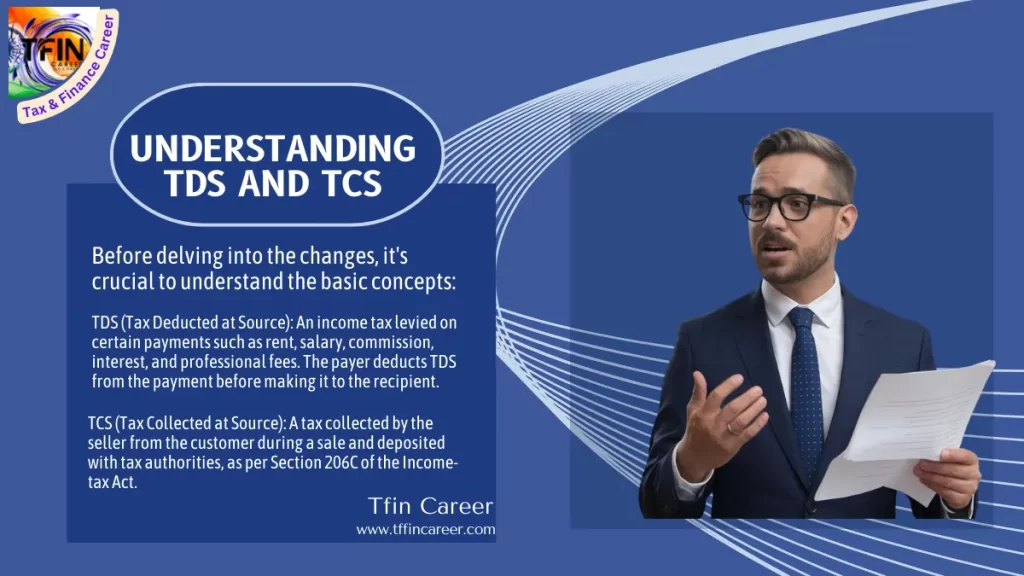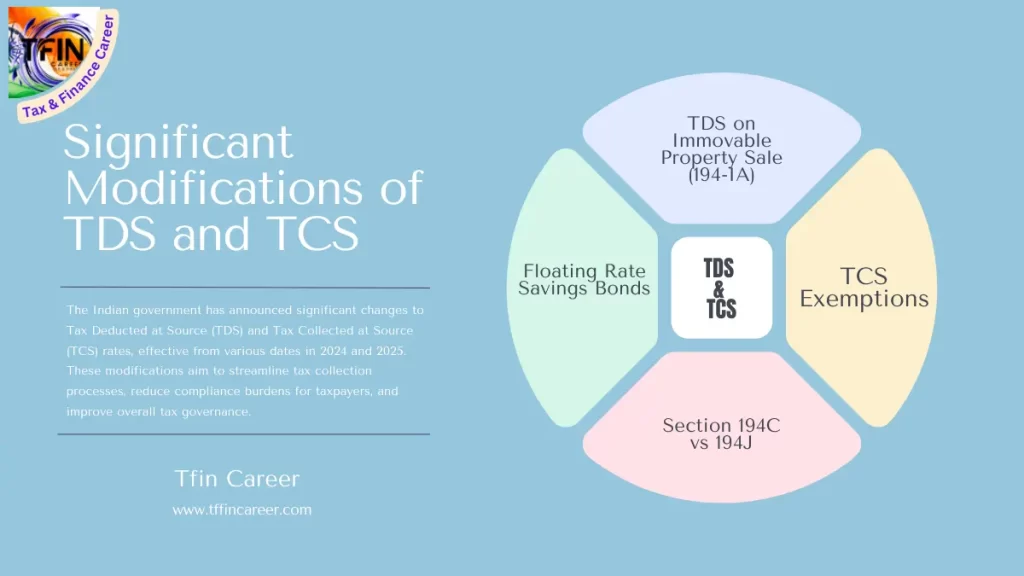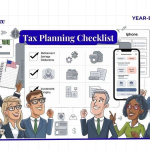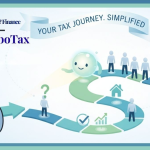TDS and TCS Rate Changes in India for 2024-2025: A Comprehensive Guide
Introduction to TDS and TCS
The Indian government has announced significant changes to Tax Deducted at Source (TDS) and Tax Collected at Source (TCS) rates, effective from various dates in 2024 and 2025. These modifications aim to streamline tax collection processes, reduce taxpayer compliance burdens, and improve overall tax governance. This comprehensive guide explores the changes and their implications, providing practical examples to illustrate their impact on various stakeholders.

Understanding
Before delving into the changes, it’s crucial to understand the basic concepts:
- TDS (Tax Deducted at Source): An income tax levied on certain payments such as rent, salary, commission, interest, and professional fees. The payer deducts TDS from the payment before making it to the recipient.
- TCS (Tax Collected at Source): A tax collected by the seller from the customer during a sale and deposited with tax authorities, as per Section 206C of the Income-tax Act.
TDS Rate Change, Impact on Salary, Check it: Big Update: New TDS Changes on Salary in Budget 2024
Key Changes
The government has reduced TDS rates for several sections, improving cash flow for businesses and individuals. Here’s a summary of the major changes:
| Section | Description | Current Rate | New Rate | Effective Date |
| 194D | Insurance commission | 5% | 2% | April 1, 2025 |
| 194DA | Life insurance policy | 5% | 2% | October 1, 2024 |
| 194G | Lottery tickets | 5% | 2% | October 1, 2024 |
| 194H | Commission/Brokerage | 5% | 2% | October 1, 2024 |
| 194-IB | Rent | 5% | 2% | October 1, 2024 |
| 194M | Certain sums by individuals/HUF | 5% | 2% | October 1, 2024 |
| 194-O | E-commerce payments | 1% | 0.1% | October 1, 2024 |
Please Check the Full TDS Rate Chart From Income Tax Portal (Click)
New TDS Provisions
- Section 194T (New): 10% TDS on payments to partners of a partnership firm (salary, remuneration, interest, bonus, or commission) exceeding ₹20,000 annually, effective April 1, 2025.
- Section 194F (Omitted): TDS on payments for repurchase of units by mutual funds or UTI will be removed from October 1, 2024.
TCS Changes
- Section 206C(1F): The 1% TCS on the sale of motor vehicles valued over ₹10 lakh will be extended to other luxury goods (to be notified), effective January 1, 2025.
Other Significant Modifications

- TDS on Immovable Property Sale (194-IA): The 1% TDS applies to the aggregate consideration, even with multiple buyers or sellers, from October 1, 2024.
- Floating Rate Savings Bonds: TDS will apply to interest payments exceeding ₹10,000 on FRSB 2020 and other specified securities from October 1, 2024.
- Section 194C vs 194J: Payments under Section 194J (professional/technical services) are excluded from Section 194C to prevent double taxation.
- Lower Deduction/Collection Certificates: Eligibility extended to include payments under Section 194Q (TDS on goods purchase) and Section 206C(1H) (TCS on goods sale).
- TCS Exemptions: The government can notify certain persons or classes exempt from TCS under Section 206C.
- Salaried Employees’ TDS Credit: An amendment to Section 192(2B) allows employees to consider TDS/TCS when calculating salary TDS, simplifying compliance.
Impact and Implications

- Reduced TDS Rates: Reduced TDS rates for various sections aim to improve cash flow for businesses and individuals.
- E-commerce Facilitation: The significant reduction in TDS for e-commerce transactions (from 1% to 0.1%) should boost online businesses.
- Partner Payments: The new 10% TDS on payments to partners introduces more structured taxation for partnership firms.
- Luxury Goods: Extending TCS to other luxury items beyond high-value vehicles may impact consumer behavior and increase tax compliance in this sector.
- Real Estate Transactions: Clarifying aggregate consideration for property sales ensures consistent TDS application in complex transactions.
- Compliance Simplification: Changes like allowing salaried employees to consider TDS/TCS credits and extending lower deduction certificate eligibility should reduce compliance burdens.
- Investment Instruments: The inclusion of Floating-Rate Savings Bonds in TDS provisions may affect some individuals’ investment strategies.
Avoid unnecessary TDS Deduction: Why You NEED to Submit Form 15G and Form 15H for Income Taxes
Practical Examples
To better understand the impact of these changes, let’s explore some real-world scenarios:

1. Insurance Commission (Section 194D)
Scenario: Rahul, an insurance agent, earns a commission of ₹100,000 in May 2025.
- Old Rule: The insurance company would deduct 5% TDS = ₹5,000
- New Rule: The company will deduct 2% TDS = ₹2,000
- Impact: Rahul receives ₹3,000 more, improving his cash flow.
2. E-commerce Transactions (Section 194-O)
Scenario: Priya sells handmade jewelry on an e-commerce platform. Her sales totaled ₹ 500,000 in November 2024.
- Old Rule: The e-commerce platform would deduct 1% TDS = ₹5,000
- New Rule: The platform will deduct 0.1% TDS = ₹500
- Impact: Priya receives ₹4,500 more immediately, significantly boosting her working capital.
3. Rent Payment (Section 194-IB)
Scenario: Amit, an individual, rents a commercial space for ₹75,000 per month starting December 2024.
- Old Rule: Amit would deduct 5% TDS = ₹3,750 per month
- New Rule: Amit will deduct 2% TDS = ₹1,500 per month
- Impact: The landlord receives ₹2,250 more monthly, while Amit has to manage a smaller upfront TDS payment.
4. Partnership Firm Payments (New Section 194T)
Scenario: XYZ Partnership pays partner Suresh a total of ₹2,500,000 in FY 2025-26 as salary and profit share.
- Old Rule: No TDS was required
- New Rule: XYZ Partnership must deduct 10% TDS = ₹250,000
- Impact: Suresh receives ₹250,000 less upfront but can claim it as a tax credit. The firm has new compliance responsibilities.
5. Luxury Goods Purchase (Section 206C(1F))
Scenario: Meera buys a luxury watch worth ₹1,500,000 in February 2025.
- Old Rule: No TCS applicable (only on vehicles above ₹10 lakh)
- New Rule: Seller collects 1% TCS = ₹15,000
- Impact: Meera pays an additional ₹15,000 upfront but can claim it as tax credit. The government gets advance tax collection on luxury purchases.
6. Real Estate Transaction (Section 194-IA)
Scenario: Three friends jointly purchased a property for ₹9,000,000 (₹3,000,000 each) in December 2024.
- Old Rule: Unclear whether TDS applies to individual shares or the total amount
- New Rule: 1% TDS on total consideration = ₹90,000
- Impact: Clarity in TDS application, ensuring proper tax collection on high-value joint purchases.
7. Online Marketplace Seller (Sections 194-O and 206C(1H))
Scenario: Small business owner Vikram sells products worth ₹2,000,000 through online and offline channels in FY 2024-25.
- Old Rule:
- E-commerce platform deducts 1% TDS on online sales
- Vikram collects 0.1% TCS on offline sales above ₹50 lakh
- New Rule:
- E-commerce platform deducts 0.1% TDS on online sales
- Vikram can apply for a lower TCS collection certificate
- Impact: Reduced TDS on online sales improves cash flow. The option for a lower TCS certificate can further ease the tax burden based on Vikram’s projected income and tax liability.
8. Mutual Fund Investments (Section 194F Omission)
Scenario: Anita redeems units from her equity mutual fund worth ₹1,200,000 in November 2024.
- Old Rule: Potential TDS on gains at 20%
- New Rule: No TDS on redemption
- Impact: Anita receives the full redemption amount without TDS, improving liquidity. However, she must ensure proper tax payment on gains during her income tax filing.
Conclusion on TDS and TCS
These changes reflect the government’s efforts to rationalize tax collection processes, reduce compliance burdens, and improve overall tax governance. Key takeaways include:
- Reduced TDS rates generally improve immediate cash flow for recipients.
- Some sectors (e-commerce, rental income) see significant reductions in upfront tax deductions.
- New TDS on partnership payments introduces tax collection at source for a previously unaffected area.
- Extension of TCS to luxury goods broadens the tax collection net.
- Clarifications on real estate TDS ensure consistent application in complex scenarios.
It is essential to note that while these changes often result in more funds available immediately, the overall tax liability remains unchanged. The deducted or collected tax is an advance payment or credit against the total tax due for the financial year.
Businesses and individuals should review these changes to ensure compliance and optimize their tax planning strategies for the 2024-2025 financial year. Consulting with a tax professional is advisable to understand how these changes may impact your financial situation.
Thank you for reading this post, don't forget to subscribe!






